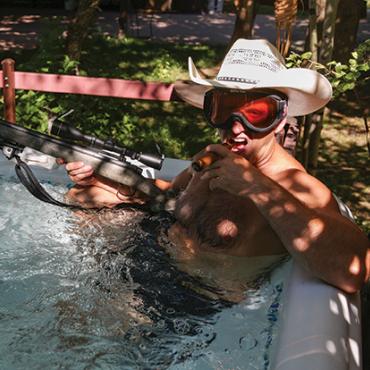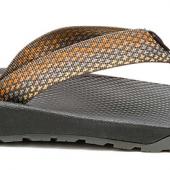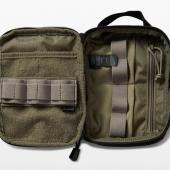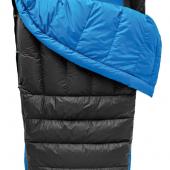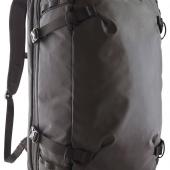Review: Hobie Mirage Revolution
Hands-free boating for summer adventures.
Here at O/B we see a lot of gear, and like a food critic being served his 500th plate of foie gras, we're not easily impressed. So when Hobie's PR department extolled the virtues of the Mirage pedal-drive kayak line, I received their enthusiasm with polite indifference. "Yes, yes, I'm sure it's amazing," I said, and after three email reminders, I finally drove over to the Northern Lights Barn and picked up a demo for the weekend.
After a quick tutorial and word of warning about the vulnerabilities (read: replacement cost) of the integrated MirageDrive unit, I and Fran, a friend visiting from Boston, shot south to Cliff Lake. We hauled the kayak – a Mirage Revolution 13 – down a steep bank to the water's edge. After collecting his fishing gear, Fran dropped in the pedal-drive, clambered aboard, and was off. I loaded up my WaterMaster kickboat and set off after him.
And that's when the virtues of the Mirage began to come into focus. Fran was leisurely pedaling his boat, glancing around at the scenery, while I, rowing like a slave on a Roman galley, couldn't keep up. Not by a longshot – the guy was cutting a freakin' wake through the clear alpine water.
When he finally stopped to rig up his rod, I managed to catch him. "What do you think?" I asked, gasping for air. "This thing's cool!" he replied, and proceeded to smile for the next three hours as he pedaled the lake, routinely hooking 18-inch rainbows on small nymphs fished right off the shoreline.
Loaded with Features
I took the boat out next, and sized up its numerous features: adjustments on the pedal-drive for different leg lengths, roomy storage compartments, a built-in tackle box, and cargo nets front and rear for clothing and duffel bags. At about 80 pounds, it's light enough that I could haul it around myself, though it took two trips with the awkward pedal-drive unit. The rotomolded polyethylene construction takes a beating, and the sail mount gives one the option to let Mother Nature do the work on longer trips. It even has an optional livewell for the serious fisherman, with easy access between the legs.
The steering system – a one-handed lever, located at the paddler's left hip, routed back to the rudder by rope-and-pulley – is pretty sensitive and took some getting used to, with lots of overcorrections at first. But eventually I got the hang of it, and controlling my direction with a thumb and two fingers made navigation easy and convenient. Another rope on the right side retracts or releases the rudder, so you can keep it up during loading/unloading and easily drop it down once you're underway in deep water.
Versatility
Pulling out the pedal-drive, I installed a plug, assembled the two-piece paddle, and used the boat as a normal sit-on-top kayak. It tracked well, especially with the lever-action rudder – I could set it a few degrees off center to account for wind and current, allowing me to keep my paddlestrokes even. For deeper water, the pedal-drive can be left inside; with the flaps in vertical position, it serves as a pretty effective keel, enhancing tracking and stability.
Wide Appeal
In addition to fishing, the Mirage works well as a cruiser. It's also great exercise – especially for cyclists who want to mix things up. Slipping into Hyalite Reservoir, I let 'er rip and hauled ass across the lake, making the far shore in 10 minutes, covered with sweat. After dunking in the water to cool off, I returned at a steadier pace, still burning calories but also taking in the views. My recumbant kayak drew second-glances and outright stares from the other boaters. Back at the ramp, several people were unable to contain their curiosity, approaching me to inquire about this strange watercraft. I let a few try it out, and they all returned grinning. "This is fun!" was the universal assessment.
Shortcomings
There's really only two problems with this boat, both minor. The rudder, when cranked over to one side, tends to slip back to the middle when you pedal hard and subject it to considerable water resistance. Hobie must know about this weakness, as there's a little V-shaped catch to lock the rudder rope in place. I initially thought it might be a fishing-line cutter, and remembering the "you break it, you buy it" look I got from the rental guy, I resorted to an occasional hard crank to set the rudder back into place. Also, the rudder-control lever, when rotated all the way right, poked into my left glute. An occasional shimmy to the right alleviated the discomfort.
Summary
The Mirage Revolution 13, with its $2,000 price tag, is certainly not cheap relative to other sit-on-top kayaks. But the pedal-drive is pretty incredible, and the boat makes an excellent craft for fishing Montana's lakes and deeper rivers. It's extremely well-made and sports loads of features not mentioned here. It's also efficient, versatile, and fun. In short, the PR folks were right – it's an impressive boat indeed. So while I may be too cheap to pick one up new, I will certainly be on the lookout for a used model, to add to my existing fleet of canoes and rafts.
The Mirage Revolution 13 can be purchased at Northern Lights Trading Company in Bozeman. Find out more about this and other MirageDrive models at hobiecat.com.


